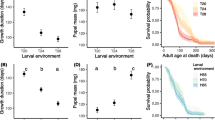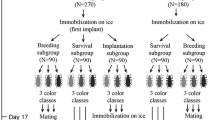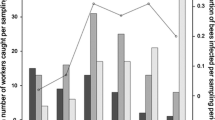Abstract
Host susceptibility and patterns of infection are predicted to differ between males and females due to sex-based tradeoffs between the demands of reproduction and costly immune defenses. In this study, we examined immune defenses and the response to experimental infection by a protozoan parasite, Ophryocystis elektroscirrha, in male and female monarch butterflies, Danaus plexippus. We quantified two measures of immunity in late instar larvae: the concentration of circulating hemocytes and mid-gut phenoloxidase activity, and also quantified final parasite loads, body size, longevity, and wing melanism of adult butterflies. Results showed that females had greater average hemocyte counts than males in the absence of infection; males, but not females, showed an increased concentration of hemocytes in the presence of infection. However, higher hemocyte concentrations in larvae were not significantly correlated with lower adult parasite loads, and mid-gut phenoloxidase activity was not significantly associated with hemocyte counts or parasite treatments. Among unparasitized females, greater hemocyte concentrations were costly in terms of reduced body size, but for parasite-treated females, hemocyte concentrations and body size were positively associated. Across all monarchs, unparasitized butterflies showed greater wing melanism (darker forewings) than parasitized monarchs. Overall, this study provides support for differential costs of immune defenses in male and female monarch butterflies, and a negative association between parasite infection and monarch wing melanism.


Similar content being viewed by others
References
Abbot P, Dill LM (2001) Sexually transmitted parasites and sexual selection in the milkweed leaf beetle, Labidomera clivicollis. Oikos 92(1):91–100
Ackery PR, Vane-Wright RI (1984) Milkweed butterflies: their cladistics and biology. Cornell University Press, Ithaca, NY
Adamo SA (2004) Estimating disease resistance in insects: phenoloxidase and lysozyme-like activity and disease resistance in the cricket Gryllus texensis. J Insect Physiol 50(2–3):209–216
Adamo SA, Jensen M et al (2001) Changes in lifetime immunocompetence in male and female Gryllus texensis (formerly G-integer): trade-offs between immunity and reproduction. Anim Behav 62:417–425
Ahtiainen JJ, Alatalo RV et al (2005) A trade-off between sexual signalling and immune function in a natural population of the drumming wolf spider Hygrolycosa rubrofasciata. J Evol Biol 18(4):985–991
Altizer SM, Oberhauser RV (1999) Effects of the protozoan parasite Ophryocystis elektroscirrha on the fitness of monarch butterflies (Danaus plexippus). J Invertebr Pathol 74(1):76–88
Altizer SM, Oberhauser RV et al (2000) Associations between host migration and the prevalence of a protozoan parasite in natural populations of adult monarch butterflies. Ecol Entomol 25(2):125–139
Andersson M (1994) Sexual selection. Princeton Univeristy Press, Princeton, NJ
Armitage SAO, Siva-Jothy MT (2005) Immune function responds to selection for cuticular colour in Tenebrio molitor. Heredity 94(6):650–656
Barnes AI, Siva-Jothy MT (2000) Density-dependent prophylaxis in the mealworm beetle Tenebrio molitor L-(Coleoptera: Tenebrionidae): cuticular melanization is an indicator of investment in immunity. Proc R Soc Lond B Biol Sci 267(1439):177–182
Boots M, Begon M (1993) Trade-offs with resistance to a granulosis-virus in the indian meal moth, examined by a laboratory evolution experiment. Fun Ecol 7(5):528–534
Brower LP, Malcolm M (1991) Animal migrations––endangered phenomena. Am Zoo 31(1):265–276
Brower LP, Fink M et al (1995) On the dangers of interpopulational transfers of monarch butterflies––discussion. Bioscience 45(8):540–544
Cerenius L, Soderhall K (2004) The prophenoloxidase-activating system in invertebrates. Immunol Rev 198(1):116–126
Chernysh SI, Filatova K et al (2004) Cytotoxic activity of blowfly Calliphora vicina hemocytes. J Insect Physiol 50(9):777–781
Cotter SC, Wilson K (2002) Heritability of immune function in the caterpillar Spodoptera littoralis. Heredity 88:229–234
Cotter SC, Hails K et al (2004a) Density-dependent prophylaxis and condition-dependent immune function in Lepidopteran larvae: a multivariate approach. J Anim Ecol 73(2):283–293
Cotter SC, Kruuk LEB et al (2004b) Costs of resistance: genetic correlations and potential trade-offs in an insect immune system. J Evol Biol 17(2):421–429
Crawley MJ (2002) Statistical computing: an introduction to data analysis using S-plus. John Wiley and Sons, West Sussex, England
da Silva C, Dunphy GB et al (2000) Interaction of hemocytes and prophenoloxidase system of fifth instar nymphs of Acheta domesticus with bacteria. Deve Comp Immunol 24(4):367–379
Davis AK, Farrey BD et al (2005) Variation in thermally induced melanism in monarch butterflies (Lepidoptera: Nymphalidae) from three North American populations. J Therm Biol 30(5):410–421
de Roode JC, Gold BD et al (2007) Virulence determinants in a natural butterfly-parasite system. Parasitology 134:657–668
Dunphy GB (1991) Phenoloxidase activity in the serum of 2 species of insects, the gypsy-moth, Lymantria dispar (Lymantriidae) and the greater wax moth, Galleria mellonella (Pyralidae). Comp Biochem Physiol Biochem Mol Biol 98(4):535–538
Eslin P, Prevost G (1996) Variation in Drosophila concentration of haemocytes associated with different ability to encapsulate Asobara tabida larval parasitoid. J Insect Physiol 42(6):549–555
Fedorka KM, Zuk G et al (2004) Immune suppression and the cost of reproduction in the ground cricket, Allonemobius socius. Evolution 58(11):2478–2485
Freitak D, Ots I et al (2003) Immune response is energetically costly in white cabbage butterfly pupae. Proc R Soc Lond B Biol Sci 270:S220–S222
Freitak D, Vanatoa I et al (2005) Formation of melanin-based wing patterns is influenced by condition and immune challenge in Pieris brassicaeEntomologia Experimentalis Et Applicata 116(3):237–243
Gillespie JP, Burnett I et al (2000) The immune response of the desert locust Schistocerca gregaria during mycosis of the entomopathogenic fungus, Metarhizium anisopliae var acridum. J Insect Physiol 46(4):429–437
Gillespie JP, Kanost MR et al (1997) Biological mediators of insect immunity. Ann Rev Entomol 42:611–643
Gray DA (1998) Sex differences in susceptibility of house crickets, Acheta domesticus, to experimental infection with Serratia liquefaciens. J Invertebr Pathol 71(3):288–289
Hooper RE, Tsubaki Y et al (1999) Expression of a costly, plastic secondary sexual trait is correlated with age and condition in a damselfly with two male morphs. Physiol Entomol 24(4):364–369
Kurtz J, Sauer KP (2001) Gender differences in phenoloxidase activity of Panorpa vulgaris hemocytes. J Invertebr Pathol 78(1):53–55
Kurtz J, Wiesner A et al (2000) Gender differences and individual variation in the immune system of the scorpionfly Panorpa vulgaris (Insecta: Mecoptera). Deve Comp Immunol 24(1):1–12
Leong KLH, Kaya HK et al (1992) The occurrence and effect of a protozoan parasite Ophryocystis elektroscirrha (Negregarinida: Ophryocystidae) on overwintering monarch butterflies Danaus plexippus (Lepidoptera: Danaidae) from two California winter sites. Ecol Entomol 17(4):338–342
Leong KLH, Yoshimura MA et al (1997) Instar susceptibility of the monarch butterfly (Danaus plexippus) to the Neogregarine parasite, Ophryocystis elektroscirrha. J Invertebr Pathol 69:79–83
McKean KA, Nunney L (2001) Increased sexual activity reduces male immune function in Drosophila melanogaster. Proc Natl Acad Sci USA 98(14):7904–7909
McKean KA, Nunney L (2005) Bateman’s principle and immunity: phenotypically plastic reproductive strategies predict changes in immunological sex differences. Evolution 59(7):1510–1517
McLaughlin RE, Myers J (1970) Ophryocystis-elektroscirrha sp. n. a. neogregarine pathogen of monarch butterfly Danaus-plexippus (L) and florida queen butterfly D-Gilippus-berenice cramer. J Protozool 17(2):300–305
Moore SL, Wilson K (2002) Parasites as a viability cost of sexual selection in natural populations of mammals. Science 297(5589):2015–2018
Moret Y, Schmid-Hempel P (2000) Survival for immunity: the price of immune system activation for bumblebee workers. Science 290(5494):1166–1168
Nigam Y, Maudlin I et al (1997) Detection of phenoloxidase activity in the hemolymph of tsetse flies, refractory and susceptible to infection with Trypanosoma brucei rhodesiense. J Invertebr Pathol 69(3):279–281
Norris K, Evans MR (2000) Ecological immunology: life history trade-offs and immune defense in birds. Behav Ecol 11(1):19–26
Oberhauser KS (1997) Fecundity, lifespan and egg mass in butterflies: effects of male-derived nutrients and female size. Fun Ecol 11(2):166–175
Oberhauser KS (2004) Effects of female age, female mass and nutrients from males on monarch egg mass. In: Oberhauser KS, Solensky MJ (eds) The monarch butterfly: biology and conservation. University Press, Cornell, pp 21–26
Oberhauser KS, Frey Cornell (1999) Coercive mating by overwintering male monarch butterflies. The 1997 North American conference on the monarch butterfly, Montreal, Commission for Environmental Cooperation
Paskewitz SM. Brown MR et al (1989) Ultrastructural-localization of phenoloxidase in the midgut of refractory anopheles-gambiae and association of the enzyme with encapsulated Plasmodium-cynomolgi. J Parasitol 75(4):594–600
Radhika M, Nazar AKA et al (1998) Sex-linked differences in phenol oxidase in the fairy shrimp Streptocephalus dichotomus Baird and their possible role (Crustacea: Anostraca). Hydrobiologia 377:161–164
Rantala MJ, Koskimaki J et al (2000) Immunocompetence, developmental stability and wingspot size in the damselfly Calopteryx splendens L. Proc R Soc Lond B Biol Sci 267(1460):2453–2457
Rantala MJ, Roff DA et al (2007) Forceps size and immune function in the earwig Forficula auricularia L. Biol J Linnean Soc 90(3):509–516
Rice WR, Gaines SD (1994) Heads I win, tails you lose––testing directional alternative hypotheses in ecological and evolutionary research. Trends Ecol Evol 9(6):235–237
Robb T, Forbes MR (2006) Sex biases in parasitism of newly emerged damselflies. Ecoscience 13(1):1–4
Rolff J (2001) Effects of age and gender on immune function of dragonflies (Odonata, Lestidae) from a wild population. Can J Zool-Revue Canadienne De Zoologie 79(12):2176–2180
Rolff J, Siva-Jothy MT (2003) Invertebrate ecological immunology. Science 301(5632):472–475
Rolff J, Siva-Jothy MT (2004) Selection on insect immunity in the wild. Proc R Soc Lond B Biol Sci 271(1553):2157–2160
Schmid-Hempel P (2005) Evolutionary ecology of insect immune defenses. Ann Rev Entomol 50:529–551
Schmid-Hempel P, Ebert D (2003) On the evolutionary ecology of specific immune defence. Tren Ecol Evol 18(1):27–32
Sheridan LAD, Poulin R et al (2000) Sex differences in parasitic infections among arthropod hosts: is there a male bias? Oikos 88(2):327–334
Silva JEB, Boleli IC et al (2002) Hemocyte types and total and differential counts in unparasitized and parasitized Anastrepha obliqua (Diptera, Tephritidae) larvae. Braz J Biol 62(4A):689–699
Siva-Jothy MT (2000) A mechanistic link between parasite resistance and expression of a sexually selected trait in a damselfly. Proc R Soc Lond B Biol Sci 267(1461):2523–2527
Siva-Jothy MT, Tsubaki Y et al (2001) Investment in immune function under chronic and acute immune challenge in an insect. Physiol Entomol 26(1):1–5
Stoehr AM (2006) Costly melanin ornaments: the importance of taxon? Fun Ecol 20(2):276–281
Stoehr AM (2007) Inter- and intra-sexual variation in immune defence in the cabbage white butterfly, Pieris rapae L (Lepidoptera: Pieridae). Ecol Entomol 32(2):188–193
Stoehr AM, Kokko H (2006) Sexual dimorphism in immunocompetence: what does life-history theory predict? Behav Ecol 17(5):751–756
Talloen W, Van Dyck H et al (2004) The cost of melanization: butterfly wing coloration under environmental stress. Evolution 58(2):360–366
Van Hook T (1993) Non-random mating behavior in monarch butterflies overwintering in Mexico. In: Malcolm SB, Zalucki SB (eds) Biology and conservation of the monarch butterfly biology and conservation of the monarch butterfly. History Museum of Los Angeles County, Los Angeles, California, pp 49–60
Van Hook T (1996) Monarch butterfly mating ecology at a Mexican overwintering site: proximate causes of non-random mating. Ph.D thesies, Gaineville, University of Florida
Viney ME, Riley EM et al (2005) Optimal immune responses: immunocompetence revisited. Trend Ecol Evol 20(12):665–669
Wilson K, Cotter SC et al (2001) Melanism and disease resistance in insects. Ecology Letters 4(6):637–649
Yourth CP, Forbes MR et al (2002) Sex differences in melanotic encapsulation responses (immunocompetence) in the damselfly Lestes forcipatus Rambur. Can J Zool-Revue Canadienne De Zoologie 80(9):1578–1583
Zuk M (1990) Reproductive strategies and disease susceptibility––an evolutionary viewpoint. Parasitol Today 6(7):231–233
Zuk M, McKean KA (1996) Sex differences in parasite infections: patterns and processes. Int J Parasitol 26(10):1009–1023
Zuk M, Stoehr AM (2002) Immune defense and host life history. Am Nat 160:S9–S22
Zuk M, Simmons LW et al (2004) Sex differences in immunity in two species of field crickets. Can J Zool-Revue Canadienne De Zoologie 82(4):627–634
Acknowledgements
We thank Laura Gold for assistance in rearing monarchs, Jaap de Roode for guidance in experimental design and comments on earlier drafts of the manuscript, and Andy Davis for advice on image analysis of monarch forewings. Mike Siva-Jothy and Richard Naylor provided guidance for protocols involving hemocyte counts and PO assays. Les Real provided access to greenhouse space. We thank Andrew Stoehr and Karen Oberhauser whose helpful suggestions significantly improved the manuscript. Support was provided from Emory University to S. A. and by the Graduate Division of Biological and Biomedical Sciences at Emory University and a PRISM Fellowship to E. L.
Author information
Authors and Affiliations
Corresponding author
Rights and permissions
About this article
Cite this article
Lindsey, E., Altizer, S. Sex differences in immune defenses and response to parasitism in monarch butterflies. Evol Ecol 23, 607–620 (2009). https://doi.org/10.1007/s10682-008-9258-0
Received:
Accepted:
Published:
Issue Date:
DOI: https://doi.org/10.1007/s10682-008-9258-0




